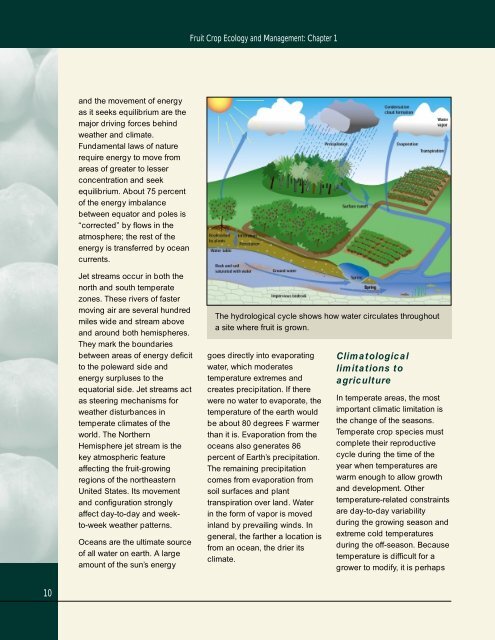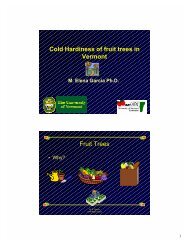Fruit Crop Ecology and Management - UVM Apple Orchard
Fruit Crop Ecology and Management - UVM Apple Orchard
Fruit Crop Ecology and Management - UVM Apple Orchard
Create successful ePaper yourself
Turn your PDF publications into a flip-book with our unique Google optimized e-Paper software.
10<br />
<strong>and</strong> the movement of energy<br />
as it seeks equilibrium are the<br />
major driving forces behind<br />
weather <strong>and</strong> climate.<br />
Fundamental laws of nature<br />
require energy to move from<br />
areas of greater to lesser<br />
concentration <strong>and</strong> seek<br />
equilibrium. About 75 percent<br />
of the energy imbalance<br />
between equator <strong>and</strong> poles is<br />
“corrected” by flows in the<br />
atmosphere; the rest of the<br />
energy is transferred by ocean<br />
currents.<br />
Jet streams occur in both the<br />
north <strong>and</strong> south temperate<br />
zones. These rivers of faster<br />
moving air are several hundred<br />
miles wide <strong>and</strong> stream above<br />
<strong>and</strong> around both hemispheres.<br />
They mark the boundaries<br />
between areas of energy deficit<br />
to the poleward side <strong>and</strong><br />
energy surpluses to the<br />
equatorial side. Jet streams act<br />
as steering mechanisms for<br />
weather disturbances in<br />
temperate climates of the<br />
world. The Northern<br />
Hemisphere jet stream is the<br />
key atmospheric feature<br />
affecting the fruit-growing<br />
regions of the northeastern<br />
United States. Its movement<br />
<strong>and</strong> configuration strongly<br />
affect day-to-day <strong>and</strong> weekto-week<br />
weather patterns.<br />
Oceans are the ultimate source<br />
of all water on earth. A large<br />
amount of the sun’s energy<br />
<strong>Fruit</strong> <strong>Crop</strong> <strong>Ecology</strong> <strong>and</strong> <strong>Management</strong>: Chapter 1<br />
The hydrological cycle shows how water circulates throughout<br />
a site where fruit is grown.<br />
goes directly into evaporating<br />
water, which moderates<br />
temperature extremes <strong>and</strong><br />
creates precipitation. If there<br />
were no water to evaporate, the<br />
temperature of the earth would<br />
be about 80 degrees F warmer<br />
than it is. Evaporation from the<br />
oceans also generates 86<br />
percent of Earth’s precipitation.<br />
The remaining precipitation<br />
comes from evaporation from<br />
soil surfaces <strong>and</strong> plant<br />
transpiration over l<strong>and</strong>. Water<br />
in the form of vapor is moved<br />
inl<strong>and</strong> by prevailing winds. In<br />
general, the farther a location is<br />
from an ocean, the drier its<br />
climate.<br />
Climatological<br />
limitations to<br />
agriculture<br />
In temperate areas, the most<br />
important climatic limitation is<br />
the change of the seasons.<br />
Temperate crop species must<br />
complete their reproductive<br />
cycle during the time of the<br />
year when temperatures are<br />
warm enough to allow growth<br />
<strong>and</strong> development. Other<br />
temperature-related constraints<br />
are day-to-day variability<br />
during the growing season <strong>and</strong><br />
extreme cold temperatures<br />
during the off-season. Because<br />
temperature is difficult for a<br />
grower to modify, it is perhaps



